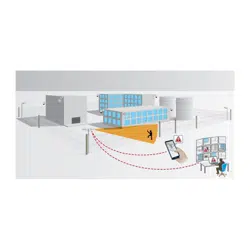Loading ...
Loading ...
Loading ...

AXIS Perimeter Defender
Get started
Calibrate - AXIS Perimeter Defender
Calibration
For AXIS Perimeter Defender to correctly interpret the scene, you must calibrate all devices. During calibration, you introduce points
of reference that provide depth and height information for the processor. You also dene the zone of interest.
Calibration consists of two tasks:
1. Perform a calibration:
- automatic — recommended in most cases. See Perform an automatic calibration on page 18.
- manual — recommended if the automatic calibration fails on a camera, for ne tuning, or when it would be
impractical to conduct a walkthrough of the scene and there are objects of known height in the scene. An
example of this is a remote perimeter with a fence line consisting of a number of evenly spaced fence posts of a
consistent height. See Perform a manual calibration on page 22.
2. Verify the calibration results. See Verify the quality of the calibration on page 20.
To speed up the conguration of a large site, you can calibrate multiple devices simultaneously. You can perform the calibration
automatically or manually, just like for a single camera. Consider the following before you calibrate multiple devices simultaneously:
• The maximum number of devices you can install and congure simultaneously depends on the CPU power and the memory
available on your computer. Too many devices in AXIS Perimeter Defender Setup can cause crashes. When the CPU overload
warning appears, install and congure a subset of the devices using the save site-feature.
• Automatic calibration of multiple devices requires more CPU resources and RAM than for a single device. On low-spec
systems this might make the computer unresponsive for some time or lead to an application crash. In case of a crash,
videos captured are still available to be used afterwards for single camera calibration.
Note
• AXIS Perimeter Defender supports different image aspect ratios according to the maximum resolution provided by the
camera. As a result, you need to redo all previous calibrations if you change the resolution. However, if you change the
stream resolution in the camera’s webpage, you don’t need to re-calibrate.
• We recommend you to use the same image aspect ratio in AXIS Perimeter Defender and in the VMS, to make sure that the
displayed information ts the image content. To nd out the aspect ratio, hover the camera name in the live view.
• If a camera moves after calibration, you need to re-calibrate it for the analytic results to be correct.
Perform an automatic calibration
With automatic calibration, you can calibrate one or more cameras by letting a person walk through the surveillance scene. The
camera automatically gathers the information required to calibrate itself.
For a successful automatic calibration:
• Don’t calibrate when there are a lot of people in the eld of view.
• Don’t calibrate when there are a lot of vehicles passing in the eld of view.
• Don’t calibrate when there are other objects moving in the eld of view. For example trees or ags moving in the wind.
• Don’t calibrate a camera which has not been installed parallel to the ground.
• The person who walks through the scene must be able to cover the whole eld of view from front to back. If that is
not possible, it is better to switch to manual calibration.
• If the camera is on a remote network but not connected as remote, the person who walks through the scene must
walk for about 5 minutes to make sure enough images are captured. This is because the frame rate is usually lower
for devices on remote networks.
1. Go to Calibration.
18
Loading ...
Loading ...
Loading ...
